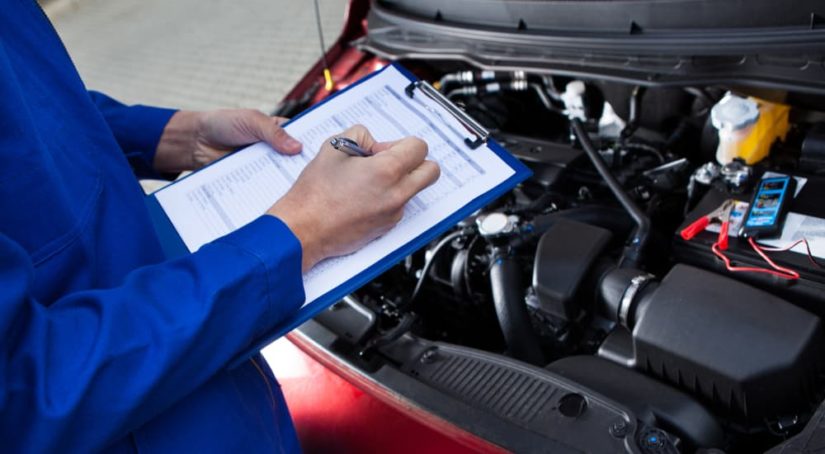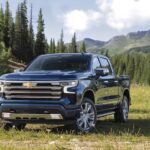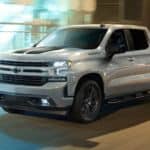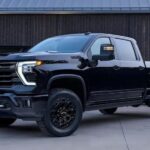The definitive answer to this question is “it depends.” That being said, we can give you the information you need to make that decision as you’re looking at new or used trucks for sale so that you can make the right choice for your particular needs. Essentially, it all comes down to understanding what you want your truck to be able to do, looking at the options that are out there, and then choosing accordingly. We can’t make that decision for you, but we’ll make a truck engine expert out of you and make it much easier for you to make that choice.
Engines 101: Different Types of Truck Engines
Before we dig into some specifics, let’s take a moment to go over the main types of engines you’ll find in trucks. For starters, we need to understand the basic way that engines function. Internal combustion engines have cylinders with pistons in them. Fiery explosions from the fuel and air mixture push those pistons up and down. The pistons are connected to a crankshaft that rotates, sending the power from those explosions through the transmission to the wheels, propelling your vehicle forward when you press the accelerator.
The number of cylinders in a truck’s engine and how they’re arranged is the foundation for everything else about that engine. There are two common configurations are found on most engines these days. In some, the cylinders are arranged in a straight line (which is to say inline), designated by an “I.” In others, the cylinders are arranged in two rows that are shaped like a V so that their bottoms can connect to the crankshaft. These are designated by a “V.” The number accompanying this designation simply refers to the total number of cylinders. An I-4 engine has four cylinders in a straight or inline arrangement, while a V8 has eight cylinders, four on each side in a V shape.
In the past, adding more cylinders to an engine was the simplest way to increase its power and overall capabilities. Essentially, adding more explosions means generating more power, which is why a V8 would typically have more horsepower than a V6, which in turn would have more power than an I-4. The rules have changed a bit since turbochargers have come into play. A turbocharger uses exhaust gas to spin a turbine that forces more air into the engine. This generates additional power, making the engine more efficient and powerful than it might be otherwise.
Finally, you should consider whether or not you want a diesel engine for your truck. These have become harder to find than they once were. The Chevy Silverado 1500 is the only full-size, light-duty truck with a diesel engine available for the 2024 model year. Looking at used pickups, you’ll find plenty of them with diesel engines. These options typically have good fuel efficiency and last a long time with great torque and towing capability. They can cost more because diesel engines tend to be more expensive to produce, which is also why hybrids and turbocharged options have replaced them in most truck lineups.
The Argument for V6 Engines
There was a time when choosing the right engine for your truck was pretty simple. A V6 engine was usually what a full-size truck, or even a midsize pickup, would come with as standard equipment. You’ll still see this on a lot of trucks these days. The 2024 Ford F-150 has a standard 2.7L Turbo V6 that offers 325 hp and 400 lb-ft of torque, while the Ram 1500 features a 3.6L Pentastar eTorque V6 with 305 hp and 273 lb-ft of torque. You can already see one issue with V6 engines on trucks: wildly different levels of power, and especially torque.
That engine from Ford is turbocharged and tuned for remarkable torque from a V6 engine, while the Ram engine is closer to what you’d expect with a typical V6 engine in a truck. The Toyota Tundra also comes with a standard V6 engine, offering 358 to 389 hp and 406 to 479 lb-ft of torque, depending on the model you look at. There’s also an available 3.4L Turbo V6 hybrid for the Tundra that boosts that up to 437 hp and 583 lb-ft of torque, which is incredible for a V6 engine and illustrates how modern technology has changed engineering.
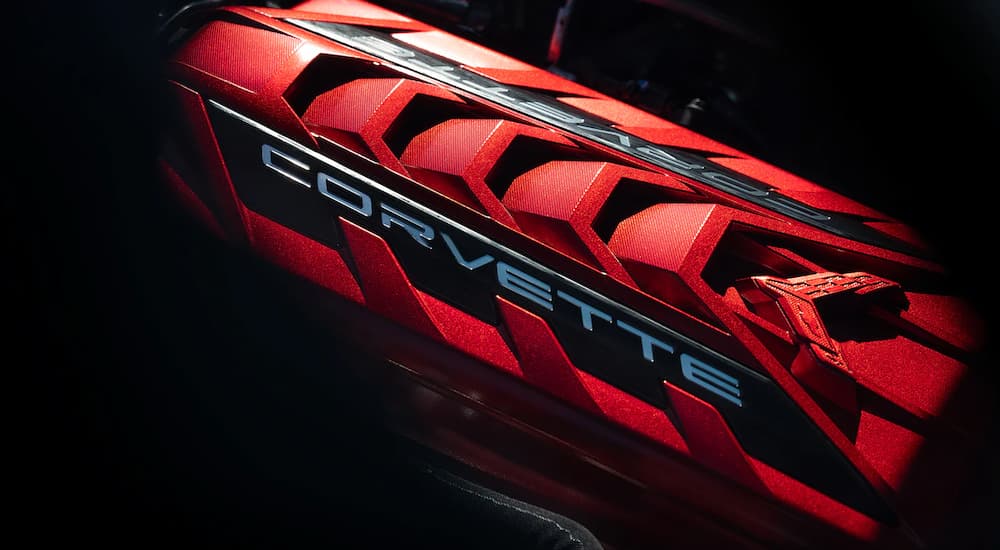
The Power of a V8 Is Undeniable
With so much power coming from V6 engines these days, are V8 engines even relevant anymore? Yes, they still are, as long as they’re designed well. The Chevy Silverado 1500 has an available 6.2L EcoTec3 V8 engine that delivers 420 hp and 460 lb-ft of torque, while the Ram 1500 has an available 5.7L HEMI V8 engine with 395 hp and 410 lb-ft of torque, and the Ford F-150 has an available 5.0L V8 with 400 hp and 410 lb-ft of torque. It may seem like you should just get a V8 and call it a day.
However, Ford shows us how things have changed, because they offer a 3.5L PowerBoost Turbo V6 hybrid that delivers 430 hp and 570 lb-ft of torque, more than any of these V8s. We’re not even getting into the bonkers Supercharged V8 available for the F-150 Raptor R that delivers 700 hp. The point is that you can’t simply look at engines and assume that a V8 will be more powerful than a V6 anymore. That’s still the case sometimes, but it varies wildly from one brand and truck to another. You have to look at the actual specs and the kind of power that each engine delivers to be able to compare them.
Can You Get a Truck With an I-4 Engine?
A few years ago this would have been a pretty silly question, particularly when looking at full-size trucks like we’ve been focused on today. But now, Chevy has made that question valid, because the 2024 Silverado 1500’s standard engine is a 2.7L TurboMax I-4 engine. Some people might laugh at the concept of an I-4 Silverado, but once you follow it up with the engine specs or 310 hp and an impressive 430 lb-ft of torque, they’ll probably stop laughing. Long-time truck fans probably feel like they’re losing their minds looking at these kinds of specs because they fly in the face of decades of experience. However, that 2.7 TurboMax I-4 makes power and torque figures comparable to the standard V6 offered by Ford, Ram, and Toyota.
What About Truck Capabilities?
Horsepower and torque look great on paper, and they determine the kind of experience you get each day behind the wheel. For many of us,. though, the most important thing is actual capability, how much weight can you load onto a truck, and how much can it tow behind it. Let’s look at a few examples:
- Chevy Silverado w/2.7L I-4: 2,260 lbs payload and 9,500 lbs towing
- Chevy Silverado w/6.2L V8: 1,980 lbs payload and 13,300 lbs towing
- Ford F-150 w/3.5L Turbo V6: up to 13,500 lbs towing
- Ram 1500 w/3.6L V6: 2,300 lbs payload and 7,730 lbs towing
- Ram 1500 w/5.7L V8: 1,940 lbs payload and 12,750 lbs towing
- Toyota Tundra w/3.4L V6: 1,940 lbs payload and 12,000 lbs towing
Here we can see just how confusing things become if you’re focused solely on what type of engine a truck has. The Silverado with its I-4 can tow more than the Ram 1500 with its V6, but the Ram 1500 with its V8 barely tops the Tundra with its standard V6 engine. Meanwhile, the F-150 with its Turbo V6 beats out all of the other V8s for best-in-class towing capacity, only surpassed by heavy-duty models like the Silverado 2500 HD or Ford F-250. In other words, you have to look beyond I-4 vs. V6 vs. V8 to see what a truck can really do.
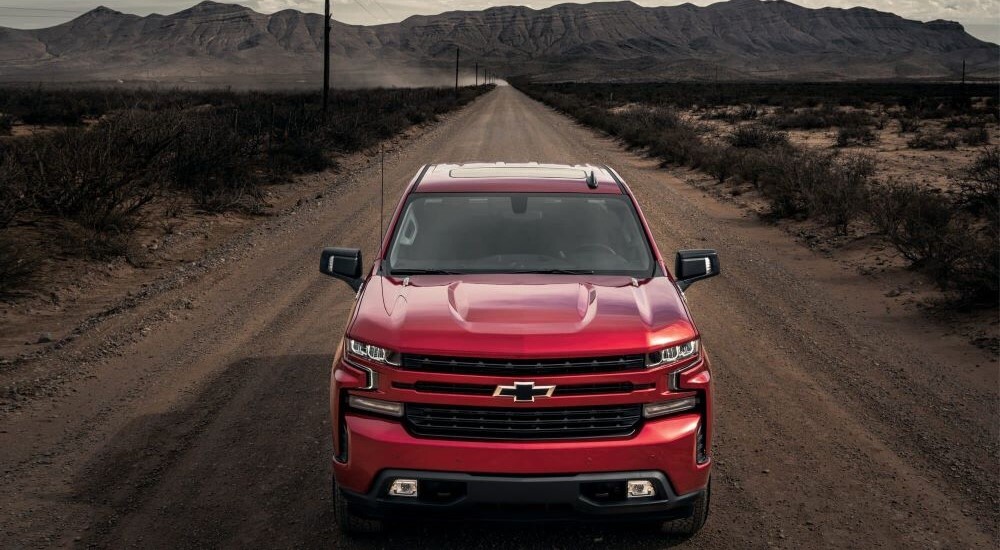
Which Engine Is Right for You?
In the end, you need to dig deeper than just looking at whether a truck has a V6 or V8 engine (or an I-4, because Chevy’s a surprisingly powerful engine) and look at the actual specs for any pickup you’re interested in. Look at how much horsepower and torque the engine puts out and, perhaps most importantly, find out the maximum payload and towing capacities for the engine and configuration of any truck before you buy it. All of this comes back to understanding what you need in a truck and making sure you find one that delivers. Only you can do that, but now you know what to look for when considering different engines, and how to find the one that meets your needs.
